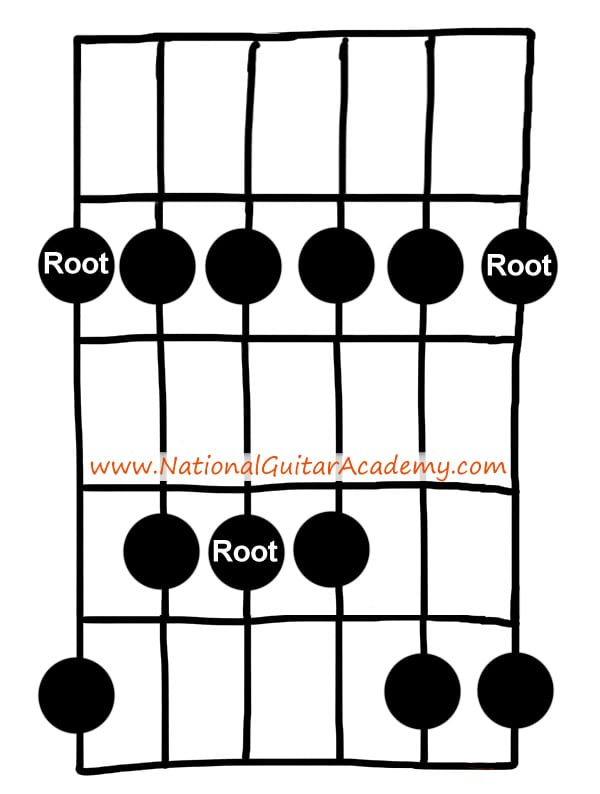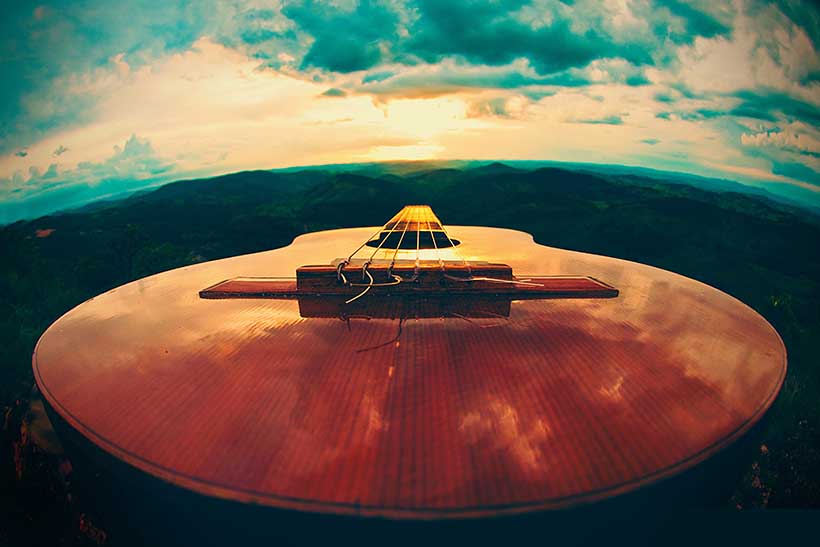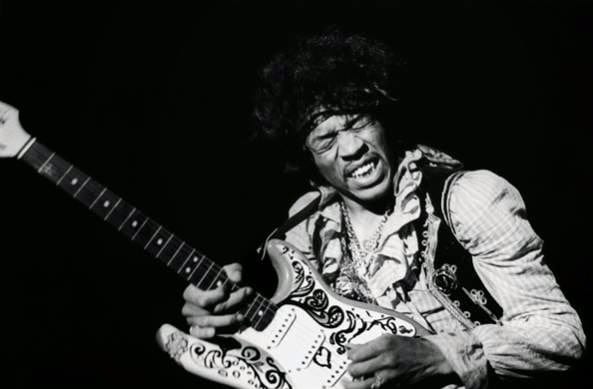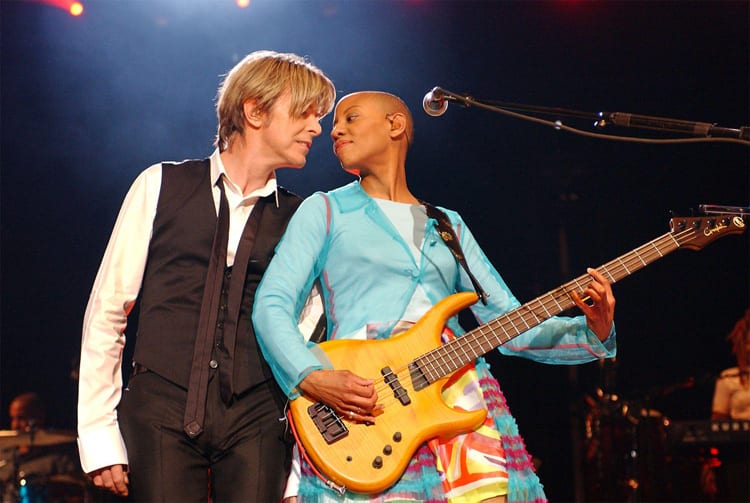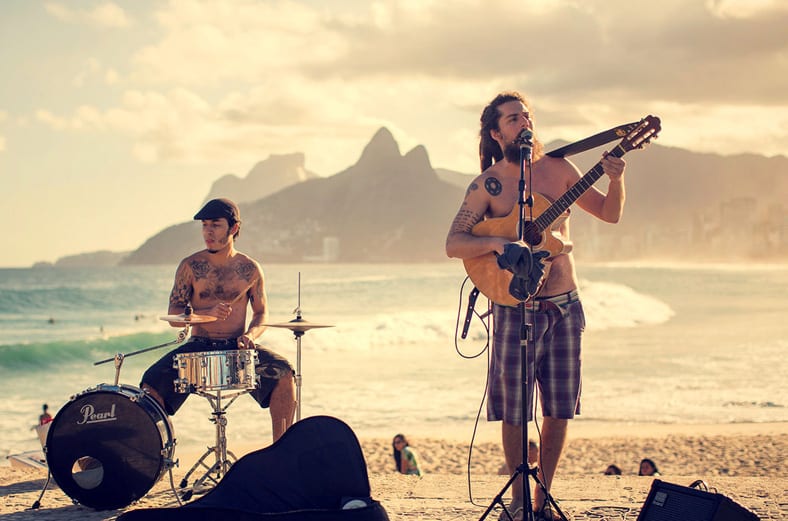Want to learn about the pentatonic scale? Strap yourself in for this super-useful lesson.
In this free guitar lesson you will learn:
- Why this scale is the ONE scale every guitarist must know
- 8 essential pentatonic licks
- 5 easy pentatonic tricks that make you sound amazing
- The #1 secret to learning pentatonic scales fast
Over 100,000 guitar-learners get our world-class guitar tips & tutorials sent straight to their inbox:
Click here to join them
Get our best guitar tips & videos
What is the pentatonic scale?
A pentatonic scale consists of 5 musical notes. (In Latin “penta” means five and “tonic” means tone. So pentatonic is just a fancy way of saying “five notes”.)
Technically, a pentatonic scale could be any 5 tone scale, but in practice when guitarists refer to the ‘pentatonic scale’, 99% of the time they are referring to the minor and major pentatonic scale.
Here is the classic pentatonic scale shape:
This is in A minor, but the scale pattern is MOVEABLE. You could play the same pattern two frets higher and you would be playing B minor.
(One higher would be C. Two higher would be D, and so on.)
A Minor Pentatonic Scale
So what is a “minor pentatonic scale”?
- The minor pentatonic scale is a minor scale that contains 5 notes.
- Minor scales tend to have a dark, bluesy sound.
- They are perfect for rock and blues music.
The minor pentatonic scale is one of the first scales you should learn as a guitar player, it’s simple and easy to learn.
What is a major pentatonic scale?
- The major pentatonic scale is the major scale, but with 2 notes removed. (So instead of having 7 notes, it has 5.)
- Important point: The major pentatonic scale is simply the major scale, in abridged form.
- This scale has a brighter sound than the minor pentatonic and is fantastic for pop, blues and jazz.
Both of these scales are essential to know for every musician.
A vital point…
CRUCIAL POINT: The minor and major pentatonic scales use the same scale patterns. When you learn the minor pentatonic scale patterns you are also learning the major pentatonic scale patterns.
This is because of ‘relative’ keys. For example, the C Major Scale shares the same notes as the A Minor Scale.
The notes contained in both scales are: A, B, C, D, E, F, G
- The root note in C Major is C – The notes are A, B, C, D, E, F, G.
- The root note in A Minor is A – The notes are A, B, C, D, E, F, G.
Can you see that the notes are the same?
So the scales are the same. The only difference between them is the root note. This means that the note you finish your licks and phrases on would change, depending on the key. The patterns of the scale are the same.
This is a huge timesaver! When you learn the Minor Pentatonic Scale patterns, you are also learning the Major Pentatonic Scales patterns at the same time. This is so cool!
Theory vs Practical
Now we’re going to look at some tricks and licks you can play.
If you’re interested in the theory that underpins the minor and major pentatonic scales, you’ll find that further down the page, after these practical tips.
5 cool licks and licks in the E minor pentatonic scale
In this video Mike shows you 5 cool flicks and licks from the E minor pentatonic scale:
Download our lead guitar cheat-sheet to make things easier
It's hard to understand which scales work with which keys.
So we created a cheat-sheet! A key and scale-finder that you can use again and again.
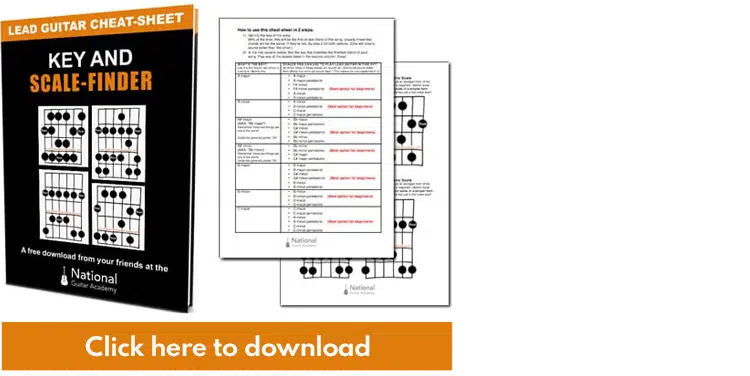
Get your personalised guitar-learning plan 🎸
Get a custom guitar-learning plan here: Click here for GuitarMetrics™
World-Class Guitar Courses 🌎
Learn from the world's best guitar educators: Click here for our guitar courses
Pentatonic Scale Guitar Licks: 3 Essential Licks
Here’s some more cool licks. Let’s dive in!
What’s a lick?
A lick is kind of like a small phrase in a language, it’s purely a musical statement. Naturally, licks are smaller than scales, there designed to create music. It’s just a short phrase.
Fancy learning a few?
Lick 1: The ‘Country’ Lick
The major pentatonic scale is used a lot in country music, here’s a classic country style major pentatonic lick in G major:
Watch out for the bending on this lick, if you’re a little bit stuck on how to bend guitar strings. Check out this article on lead guitar playing: How To Play Lead Guitar
Lick 2: The ‘Blues’ Lick
The minor pentatonic scale is often used in blues music, it’s a great way of getting a great blues sound.
This lick has a bit of a clapton vibe to it, it’s great for those old school blues tunes.
.
If you want to know more about the A minor pentatonic, go here :Learn Guitar Scales In 8 Easy Steps
Want free guitar tips and video lessons delivered to your inbox?
Join over 100,000 guitar learners and subscribe to our guitar-tips-by-email service. (It's free.)
We'll send you a series of lessons that will move you to the next level of your guitar journey.
Learn how everything fits together quickly, easily and effectively. We share ninja tips (for instant fun!) but also timeless fundamentals that will deepen your understanding.


Get our best guitar tips & videos
Our Guitar Courses
To become a better guitarist click here to see our guitar courses
Get your personalised guitar-learning plan 🎸
Want us to make a guitar-learning plan that is customised to you? Click here for GuitarMetrics™
Lick 3: The ‘Rock’ Lick
This next lick is an awesome minor pentatonic rock lick. Buckle up! It’s a fast one.
Here’s the tab :
This lick is in the key of A.
Learning the minor pentatonic scale
As the minor pentatonic scale has 5 notes, it’s useful for us to know what those notes are.
You don’t need to know this to play a pentatonic scale on the guitar, but it’s SO useful to understand this if you want to take your musical playing to the next step.
We can either think of these notes via intervals or via note names.
Learning the intervals of the minor pentatonic scale
When talking about musical intervals, we’re referring to :
The relationship that two notes have together.
In scales, 99% of the time we’re always referring to the root notes relationship with another note in the scale.
So for example, let’s say we’re learning :
- The E minor pentatonic scale.
From this, before we learn any of the notes in the E minor pentatonic scale, we know that :
- The root note of that scale is the note E. This is our starting note.
So therefore, we can relate ANY of the other notes in the scale, back to the root note.
This is what we’re referring to when we talk about intervals.
Intervals in the minor pentatonic scale
These are :
- The Root
- The Flattened 3rd
- The Perfect Fourth
- The Perfect Fifth
- The Flattened 7
These intervals are ALWAYS going to be the same in the minor pentatonic scale, regardless of what key we’re playing in.
This is the blueprint of the minor pentatonic scale.
It’s also useful to know the names of each note in a scale, however this changes depending on what key you’re in. Notes change, but the blueprint stays the same.
Let’s learn this scale in the key of E minor.
Notes in the E minor pentatonic scale
These are :
- E – The Root
- G – The Flattened Third
- A – The Perfect Fourth
- B – The Perfect Fifth
- D – The Flattened Seventh
This diagram, shows you ALL of these notes on the fretboard:
E Minor Pentatonic – Full Fretboard
If you’d like to know more about guitar scales, go here : Learn Guitar Scales In 8 Easy Steps
Over 100,000 guitar-learners get our world-class guitar tips & tutorials sent straight to their inbox:
Click here to join them
Get our best guitar tips & videos
Learning the intervals of the major pentatonic scale
Just like our major pentatonic scale, each of the notes in a major pentatonic have a specific interval relation with the root note.
Here’s what the intervals in a major pentatonic are :
- The Root
- The Major Second
- The Major Third
- The Perfect Fifth
- The Major Sixth
Can you see how these intervals are different from the minor pentatonic scale? This is because this time, we’re dealing with a major pentatonic scale.
The blueprint of this scale is ALWAYS going to be the same. Whatever key we’re in, we’ll ALWAYS be playing these intervals.
The notes of a major pentatonic scale
Let’s learn this scale in the key of G major.
The notes in a G major pentatonic are :
- G – Root
- A – Major Second
- B – Major Third
- D – Perfect Fifth
- E – Major Sixth
Here’s what those notes look like ALL over the fret board.
G Major Pentatonic – Full Fretboard
Download our lead guitar cheat-sheet to make things easier
It's hard to understand which scales work with which keys.
So we created a cheat-sheet! A key and scale-finder that you can use again and again.

Get your personalised guitar-learning plan 🎸
Get a custom guitar-learning plan here: Click here for GuitarMetrics™
World-Class Guitar Courses 🌎
Learn from the world's best guitar educators: Click here for our guitar courses
Other types of major and minor scales
In music, there are hundreds of different scales.
However, your core fundamental scales are :
- The Major Scale
- The Minor Scale
These are what form the foundations of ALL music!
You might be wondering, hang on a minute. You’ve been going on about pentatonic scales for the last 20 minutes, what on earth are major and minor scales?
- Major and minor scales and pentatonic scales are the SAME thing.
- Pentatonic scales come from major and minor scales.
I like to think of major and minor scales as the ‘parent scales’, where as pentatonic scales are the younger, cooler version of these scales.
- The pentatonic scale has 5 notes.
Where as the major and minor scales have 8 notes. These are larger versions of your pentatonic scales.
- The Major Scale = The Major Pentatonic.
- The Minor Scale = The Minor Pentatonic.
Let’s compare between the two.
The Major Scale
For this example, let’s use the key of G.
In a G major scale the notes are :
- G
- A
- B
- C
- D
- E
- F#
Here there are 7 notes.
In a pentatonic scale, we only use 5 notes.
The G Major Pentatonic
Let’s take a look at what notes are in the G major pentatonic.
- G
- A
- B
- D
- E
Can you see how these notes are taken from the G major scale? (The ‘parent’ scale?)
Let’s try this with the minor scale.
The Minor Scale
For this scale, we’re going to use the key of E minor. Let’s take a look at what notes are in the E minor scale.
- E
- F#
- G
- A
- B
- C
- D
Just like our major scale, there are 7 notes here.
Let’s compare it to the minor pentatonic scale.
The Minor Pentatonic
The notes in a E minor pentatonic are :
- E
- G
- A
- B
- D
Just like our major scale, these notes are also in the minor scale.
If you’d like to know more about guitar scales, go here: Learn Guitar Scales In 8 Easy Steps
Why would you need to know the pentatonic scale?
Pentatonic scales are really useful to know.
Scales are what help you to create music, they give you the fundamentals to:
- To help your technique.
- To help you learn faster.
They are incredibly useful. For most lead guitarists, this is the DNA of playing lead guitar.
How to play and practice your scale technique
One of the best ways to practice guitar technique is to use guitar scales. Pentatonic scales have the advantage over other scales, as they’re naturally much shorter.
This means you can practice your technique in a far more efficient way.
Quick tips for improving your technique
Play ALL your scales SLOWLY.
All students do this… They learn a cool pattern or lick and the first thing they do is try and practice as fast as they can.
This is NOT helpful for developing guitar technique.
One more time: This is NOT helpful for developing guitar technique.
Playing slowly and getting it RIGHT is the most efficient way to build muscle memory and embed the scale pattern into your playing.
Practice your scales to a metronome.
This is a great way of practicing your technique and your timing. Make sure that when you practice your scales you play each note on each click on the metronome.
Here’s a handy metronome site, if you don’t already use one: Metronome online
Alternatively you could download a metronome app on your phone or tablet.
When you play scales fast, here’s what happens
- You don’t learn the scale properly.
If you try to play the scale as fast as you can, your hands can’t process how to play the scale.
As a result of this, it takes you longer to remember the scale.
- You develop bad technique.
If you’re going super fast, you don’t give yourself the chance to make sure you’re playing each part correctly. Take your time.
Here’s what happens when you practice scales slowly
- You remember scales faster.
- Your technique becomes better.
- You become a better guitarist.
One last time: Practice slowly. 🙂
When would you need to know the pentatonic scale?
One of the main uses of the pentatonic scale is to either improvise or to create melodies.
Without the knowledge of these scales, it’s almost impossible to create music.
Here are a couple of musical situations when knowing the pentatonic scale would come in handy :
At a jam session
Let’s say you go to your local jam session, or you regularly meet up with friends to play some guitar.
Having a good grasp of the pentatonic scale is so useful, as it instantly gives you something that you can use to improvise with.
Writing music in a band
Imagine, you’ve written an awesome song with the band that you’re in. But it needs something extra, a little sprinkle on the top.
Sometimes adding a melody in is a great way of adding interest to a song. Without the knowledge of pentatonic scales, it’s much harder to do this. You’re just fishing in the dark.
This is why it’s so fundamentally important to have a good grasp of these scales.
To understand musical theory
Scales form the foundation of chords and musical theory. Having a good understanding of scales helps you understand these elements.
What Type of Guitarist Are You?
Take our 60-second quiz & get your results: Take The Quiz
Join the world's best online guitar school 🌎
- Get your own personalised guitar learning plan (customised just for YOU).
- World-class online guitar courses. Learn at your own pace.
- Community Campus & Learning Forum - A friendly community! Connect with our team & students. 😊
- Beginner Song library with chordsheets, tabs and tips. (Songs suitable for all levels!)
- Regular live streams, seminars and Q&A sessions - Learn from world-class guitar educators. Get all your questions answered!
Click here to learn more about National Guitar Academy membership 
Cool Guitar T-shirts 😎
Look cooler! Check out our merch: Click here to see our merch store
Want free guitar tips and video lessons delivered to your inbox?
Join over 100,000 guitar-learners and subscribe to our guitar-tips-by-email service. (It's free.)
We'll send you a series of lessons that will move you to the next level of your guitar journey.
Learn how everything fits together quickly, easily and effectively. We share ninja tips (for instant fun!) but also timeless fundamentals that will deepen your understanding.


Get our best guitar tips & videos
Popular Lessons
How To Learn Guitar: An 11-Step Programme For Beginners
How To Choose The Perfect Beginner Guitar
More Cool Guitar Stuff
Learn about National Guitar Academy: About Us
Join us on Facebook for daily guitar tips.
Listen to our Learn Guitar Podcast for rapid guitar progress.
Check out our free chord lessons.




